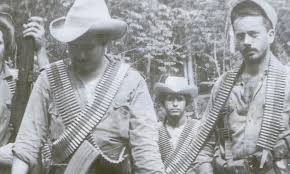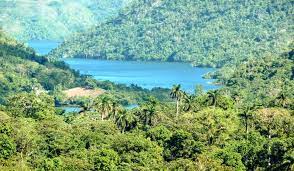MONTAÑAS DEL ESCAMBRAY, LA CADENA MONTAÑOSA MÁS ALTA DE CUBA CENTRAL. REBELIÓN DEL ESCAMBRAY. PHOTOS.
La Sierra del Escambray es una cadena montañosa en la región central de Cuba, en las provincias de Sancti Spíritus, Cienfuegos y Villa Clara.
Las montañas del Escambray están ubicadas en la región centro-sur de la isla, extendiéndose unos 80 kilómetros (50 millas) de este a oeste y 80 kilómetros (50 millas) de norte a sur. Su pico más alto, el Pico San Juan, se eleva a 960 m (3150 pies) sobre el nivel del mar.
Solo unos pocos cafetaleros vivían en la zona cuando el presidente Fulgencio Batista ordenó la construcción de un sanatorio para enfermos de tuberculosis en 1954. Hay rumores de que su esposa Martha estaba luchando contra esta enfermedad y una vez allí le encantó el lugar. Como resultado, convenció a Batista de que también le construyera una “cabaña” en la zona.
Después de la Revolución Cubana, el hospital se convirtió en escuela, ya que a mediados de la década de los 70 volvió una terapia de rehabilitación especializada similar y un uso hotelero especial. El Kurhotel también es famoso por su vasta colección de piezas originales de arte cubano. Repartidas en 210 habitaciones, vestíbulos y pasillos, se pueden encontrar cerca de 800 obras de arte de los pintores cubanos más famosos de todos los tiempos.
Las plantaciones de café en las laderas de Manicaragua de las montañas del Escambray producen granos de café que se considera que tienen un “aroma incomparable”. El tabaco que se cultiva en los planos inferiores, El Hoyo de Manicaragua, es utilizado por la fábrica de puros de la ciudad de Manicaragua.
Los primeros habitantes, los miembros de la tribu Siboneyes, llamaron a su hogar, de manera bastante inmodesta, Manicaragua, el idioma arawak para “La tierra de los valientes”.
REBELIÓN ESCAMBRAY
La rebelión del Escambray fue un conflicto armado de 1959 a 1965 en las montañas del Escambray durante el cual varios grupos insurgentes lucharon contra el gobierno cubano liderado por Fidel Castro. La rebelión fue denominada Lucha contra los bandidos por el gobierno cubano.
Los rebeldes eran una mezcla de ex soldados de Batista, agricultores locales y ex guerrilleros de izquierda que habían luchado junto a Castro contra Batista durante la Revolución Cubana. El resultado final fue la eliminación de todos los insurgentes por parte de las fuerzas del gobierno cubano en 1965.
COMIENZO
El levantamiento comenzó casi inmediatamente después del éxito de la Revolución Cubana en 1959. Fue liderado por un exguerrillero que había luchado contra Batista antes, pero rechazó el giro socialista que había tomado la Revolución Cubana y los estrechos vínculos subsiguientes con la Unión Soviética. Los pequeños agricultores terratenientes, que no estaban de acuerdo con la colectivización de las tierras agrícolas cubanas por parte del gobierno socialista, también jugaron un papel central en la fallida rebelión. El levantamiento también fue respaldado en secreto por la CIA y la administración Eisenhower debido a los vínculos de Castro con la Unión Soviética.
Los campesinos guajiros insurgentes contaban con la ayuda de algunas ex fuerzas de Batista, pero estaban dirigidos principalmente por ex rebeldes DRE (Movimiento 13 de Marzo), como los anticomunistas Osvaldo Ramírez y el comandante William Alexander Morgan, quienes habían combatido los casquitos de Batista en el mismo lugar. área sólo unos años antes (el propio Morgan fue ejecutado en 1961, mucho antes de que terminara la resistencia). Ramírez y Morgan fueron vistos por Estados Unidos como posibles opciones prodemocráticas para Cuba y enviaron exiliados cubanos entrenados por la CIA para promover y difundir la idea de que eran una alternativa a Castro.
INSURRECCIÓN
La CIA proporcionó algo de ayuda a los insurgentes, pero retiró todo el apoyo después de la fallida invasión de Bahía de Cochinos en 1961, asegurando su derrota final. Algunos de los fracasos podrían atribuirse al “despliegue” de agentes de la CIA en Cuba por parte de Castro. Después del fracaso de Bahía de Cochinos, Osvaldo Ramírez regresó a las montañas del Escambray y rechazó una oferta del emisario de Castro, el comandante Faure Chomón, de rendirse.
La principal táctica del gobierno cubano fue desplegar miles de tropas contra pequeños grupos de rebeldes, formando círculos de cerco cada vez más estrechos. A los líderes comunistas que Castro envió para limpiar las montañas del Escambray se les ordenó exterminar a los rebeldes. Debían “peinarse codo con codo” hasta que hubieran despejado por completo las colinas de rebeldes anticomunistas. Los líderes de las fuerzas insurgentes Lucha contra Bandidos (LCB) fueron los comandantes Raúl Menéndez Tomassevich, miembro fundador del Partido Comunista de Cuba, y Lizardo Proenza.
FRACASO
Tanto su menor número como la falta de asistencia externa, en particular suministros, finalmente llevaron a la derrota de los rebeldes. Las guerrillas anticomunistas superadas en número a menudo lucharon hasta la muerte. Las fuerzas cubanas utilizaron barridos por largas columnas de milicias, lo que le costó al gobierno pérdidas sustanciales pero finalmente ganó la guerra. El asesor hispano-soviético Francisco Ciutat de Miguel, que también estuvo presente en la invasión de Bahía de Cochinos, jugó un papel importante en la operación de pacificación. Castro empleó una fuerza abrumadora, enviando a veces hasta 250,000 hombres, casi todos (incluidos 3,500 de las 4,000 muertes del gobierno) eran milicianos. La insurgencia fue finalmente aplastada por el uso de los Castro de sus números muy superiores. Algunos de los insurgentes finalmente se rindieron pero fueron inmediatamente ejecutados por un pelotón de fusilamiento. Solo un puñado logró escapar.
LEGADO
La Guerra contra los Bandidos duró más e involucró a más soldados que la lucha anterior contra las fuerzas de Batista.
Raúl Castro afirmó en un discurso en 1970 que la rebelión mató a 500 miembros de las Fuerzas Armadas Revolucionarias de Cuba. Se desconoce el número de muertos de los rebeldes y otras personas involucradas en la rebelión (como civiles y milicias progubernamentales). Las estimaciones del total de muertes de combatientes oscilan entre 1.000 y 7.000.
ESCAMBRAY MOUNTAINS, THE HIGHEST MOUNTAIN CHAIN IN CENTRAL CUBA. ESCAMBRAY REBELLION.
The Escambray Mountains is a mountain chain in the central region of Cuba, in the provinces of Sancti Spíritus, Cienfuegos, and Villa Clara.
The Escambray Mountains are located in the south-central region of the island, extending about 80 kilometers (50 mi) from east to west, and 80 kilometers (50 mi) from north to south. Their highest peak, Pico San Juan, rises to 960 m (3,150 ft) above sea level.
Only a few coffee farmers lived in the area when President Fulgencio Batista ordered the construction of a sanatorium for tuberculosis patients in 1954. There are rumors that his wife Martha was fighting this disease and once there he loved the place. As a result, she convinced Batista to build him a “cottage” in the area too.
After the Cuban Revolution, the hospital became a school since the mid-’70s he returned a similar to specialized rehabilitation therapy and special hotel use. The Kurhotel is also famous for its vast collection of original pieces of Cuban art. Spread over 210 rooms, lobbies, and hallways, nearly 800 pieces of art from the most famous Cuban painters of all time can be found.
The coffee plantations on the Manicaragua slopes of the Escambray mountains produce coffee beans that are considered to have an “unparalleled aroma”. The tobacco grown on the lower planes, El Hoyo de Manicaragua, is used by the cigar factory of Manicaragua City.
The earliest inhabitants, Siboneyes tribesmen, called their home, rather immodestly, Manicaragua, the Arawak language for “The Land of the Brave”.
ESCAMBRAY REBELLION
The Escambray rebellion was an armed conflict from 1959 to 1965 in the Escambray Mountains during which several insurgent groups fought against the Cuban government led by Fidel Castro. The rebellion was called the Struggle Against Bandits (Spanish: Lucha contra Bandidos) by the Cuban government.
The rebels were a mix of former Batista soldiers, local farmers, and leftist ex-guerrillas who had fought alongside Castro against Batista during the Cuban Revolution. The end result was the elimination of all insurgents by Cuban government forces in 1965.
BEGINNING
The uprising began almost immediately after the success of the Cuban Revolution in 1959. It was led by an ex-guerrilla that had fought against Batista before but rejected the socialist turn the Cuban Revolution had taken and the ensuing close ties with the Soviet Union. Small landowning farmers, who disagreed with the socialist government’s collectivization of Cuban farmlands also played a central role in the failed rebellion. The uprising was also secretly backed by the CIA and the Eisenhower administration because of Castro’s ties with the Soviet Union.
The insurgent guajiro rural farmers were aided by some former Batista forces but were led mostly by former DRE rebels (13 March Movement), such as the anti-communists Osvaldo Ramirez and Comandante William Alexander Morgan, both of whom had fought Batista’s casquitos in the same area only a few years before (Morgan himself was executed in 1961, long before the resistance ended). Ramirez and Morgan were viewed by the United States as potential pro-democracy options for Cuba and sent CIA-trained Cuban exiles to promote and spread the word of them being an alternative to Castro.
INSURGENCY
The CIA provided some aid to the insurgents but withdrew all support after the failed Bay of Pigs Invasion in 1961, ensuring their ultimate defeat. Some of the failures could be attributed to Castro’s “roll-up” of CIA operatives in Cuba. After the Bay of Pigs failure, Osvaldo Ramirez returned to the Escambray Mountains and declined an offer by Castro’s emissary, Comandante Faure Chomón, to surrender.
The main tactic of the Cuban government was to deploy thousands of troops against small groups of rebels, forming progressively constricting rings of encirclement. The communist leaders that Castro sent to clear the Escambray Mountains were ordered to exterminate the rebels. They were to “comb the brush elbow to elbow” until they had completely cleared the hills of anti-communist rebels. The leaders of the insurgent forces Lucha contra Bandidos (LCB) were Commandantes Raul Menendez Tomassevich, a founding member of the Communist Party of Cuba, and Lizardo Proenza.
DEFEAT
Both their smaller numbers and the lack of outside assistance, particularly supplies, eventually led to the rebels’ defeat. The outnumbered anti-communist guerrillas often fought to the death. Cuban forces used sweeps by long columns of militia, which cost the government substantial losses but ultimately won the war. The Spanish-Soviet advisor Francisco Ciutat de Miguel, who was also present at the Bay of Pigs Invasion, played a major role in the pacification operation. Castro employed overwhelming force, at times sending in as many as 250,000 men, almost all of whom (including 3,500 out of the 4,000 government fatalities) were militia. The insurgency was eventually crushed by the Castros’ use of their vastly-superior numbers. Some of the insurgents ultimately surrendered but were immediately executed by firing squad. Only a handful managed to escape.
LEGACY
The War Against the Bandits lasted longer and involved more soldiers than the previous struggle against Batista’s forces.
Raúl Castro claimed in a speech in 1970 that the rebellion killed 500 members of the Cuban Revolutionary Armed Forces. The death toll of the rebels and others involved in the rebellion (such as civilians and pro-government militias) is unknown. Estimates for total combatant deaths range from 1,000 to 7,000.
Agencies/ Wiki/ EscambrayMount.Story/ Extractos/ Excerpts/ Internet Photos/ Arnoldo Varona/ www.TheCubanHistory.com
THE CUBAN HISTORY, HOLLYWOOD.



 MONTAÑAS DEL ESCAMBRAY, la Cadena Montañosa más Alta de Cuba Central. Rebelión del Escambray. PHOTOS. * ESCAMBRAY MOUNTAINS, the Highest Mountain Chain in Central Cuba. The Escambray Rebellion. PHOTOS
MONTAÑAS DEL ESCAMBRAY, la Cadena Montañosa más Alta de Cuba Central. Rebelión del Escambray. PHOTOS. * ESCAMBRAY MOUNTAINS, the Highest Mountain Chain in Central Cuba. The Escambray Rebellion. PHOTOS









